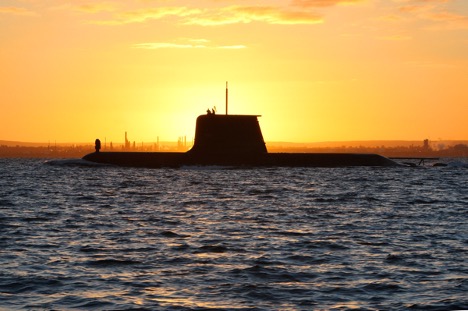By Marcus Hellyer
With regard to the offshore patrol vessels and the continuing upgrades to the Collins class submarines, progress continues.
Offshore patrol vessels
The Australian National Audit Office’s recent performance audit of the OPV project was as positive as any ANAO report I’ve ever seen.
When the government announced the winner of the tender, it was surprising to many that the German company Lürssen working with the inexperienced Australian shipbuilder Civmec was chosen over the experienced Australian shipbuilder Austal and its German design partner Fassmer. The ANAO audit also reveals that Lürssen’s bid was the most expensive of the three options.
However, the report notes that despite the higher cost, the tender evaluation panel assessed the Lürssen proposal to offer ‘genuinely … distinct advantages (i.e. additional value) over the AustalFassmer proposal—including a superior capability, a sound prime contracting model, program management and shipbuilding proposal, along with a modern purpose built facility’.
In light of that assessment, the audit report contains two intriguing statements that point to some highly unusual elements in the project’s decision-making process.
In contrast to the standard public service practice of providing frank advice, Defence didn’t recommend its preferred option to the government and stated this was at the defence ministers’ direction. The ANAO was unsupportive of that approach: ‘A core function of departments of state is to provide substantive advice to responsible ministers, to inform governmental decision-making … Defence should have offered its ministers an opinion on its assessment of value for money in the circumstances.’
The ANAO also queried the government’s last-minute announcement that it would bring Austal, whose own bid had been unsuccessful, into the successful tenderer’s bid. This, the ANAO notes, was not covered in the terms of the original request for tender; imposed greater cost, effort and scheduling pressures on Lürssen; and posed ‘potential reputational risk to Defence and the Australian Government’. Ultimately, Lürssen and Austal could not come to terms and Austal is not part of the project.
The ANAO says Defence informed it that both of these unusual things were done at the direction of the defence ministers. Unfortunately, Defence could not produce any record of either ministerial direction or consultation. Which goes to confirm the oldest (unwritten) rule of the public service: when a minister directs you to do something unusual, get it in writing.
While the project started with an incomplete design, it appears to be on budget and schedule (although risks remain). Defence likes the OPV design so much it’s going to use a variant of it as the basis of its future mine-clearance and military hydrography fleet. According to Defence they will be built in Western Australia using excess capability at Civmec’s facility in Henderson.
But one might suggest that if Defence is going demonstrate that Adelaide’s new frigate shipyard’s systems work, rather than prototype frigate blocks that are destined to become artificial reefs, it might put that state-of-the-art shipyard to work also building more OPVs—affordable ships that we can actually use—preferably in imaginative ways to enhance the navy’s warfighting capabilities.
Collins-class submarines
Ensuring the Collins submarine remains an effective capability is the key to a successful transition to the Attack class, so it’s one of the moving pieces that make up a coherent whole. In light of the demands on South Australia’s workforce I discussed in part 1, moving full-cycle dockings from Adelaide to Henderson to spread the load could be a significant risk mitigator for the entire shipbuilding enterprise—while potentially creating other risks. But a decision to move needs to be made in a timely fashion.
After the government was burned by committing to make a decision last year on whether to move and then not meeting that commitment (in fairness, things like bushfires probably consumed its attention), it now simply says it will make a decision when the time is right (Senate estimates, 21 October, page 5 and page 62) and after a ‘deliberative process’ takes place.
The government has made it very clear (page 62) that if full-cycle dockings do move west, the first one there would start in mid-2026. That’s the docking that will also be the first Collins life-of-type extension (LOTE), the program that is intended to keep them relevant for a further 10 years and bridge the gap to the future submarine.
Starting in 2026 might appear bad for two reasons. The first is that ASC, which sustains the Collins and has conducted studies into the feasibility of a move, said that it would take six years to set up a new full-cycle docking capability (page 6). So we’re already inside that window. But ASC also said it could be done in less time. One assumes this is another issue that comes down to the government’s appetite for risk.
The other reason 2026 might raise concerns is that one could assume that since the LOTE dockings are going to be more complex than a ‘regular’ full-cycle docking, it might be preferable for the new West Australian workforce and facility to cut their teeth on the last of the regular dockings rather than jump straight into the first LOTE. Again, ASC has argued this isn’t necessarily the case (page 15); a clean break and fresh start in the west in 2026 would have less ‘baggage’ and could be the best way to go.
Either way, one state is going to get bad news. But as the old saying goes, bad news doesn’t get better with time, so it would be preferable for the government to get on the front foot, make an announcement, and allow Defence and its industry partners to plan accordingly.
Marcus Hellyer is ASPI’s senior analyst for defence economics and capability.
This article was published by ASPI on November 27, 2020.
Featured Image: Royal Australian Navy.


